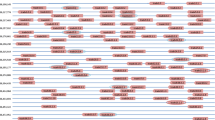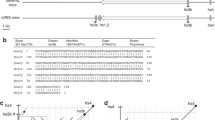Abstract
Past studies of the channel catfish immunoglobulin heavy-chain (IgH) locus indicates that it lacks an Eμ enhancer in the J H –Cμ1 intron but does have an enhancer, termed Eμ3′, in the μ–δ intergenic region. The positioning of the catfish enhancer downstream of the μ-chain exons is predicted to be unfavorable for antibody-affinity maturation in catfish, and would also have been an impediment to the evolution of class switch recombination, had it existed in early tetrapods. To determine if this downstream enhancer is a general feature of teleost fish, we have identified the location of the transcriptional enhancer in the zebrafish IgH locus. We find that zebrafish, like catfish, only have an Eμ3′-like enhancer that has cross-species activity, but which is B-cell-specific in its activity. A 300-bp region of the zebrafish enhancer shares sequence homology with the core of the catfish Eμ3′, although there has been loss and gain of specific octamer enhancer motifs. Mutagenesis studies demonstrate that the zebrafish IgH enhancer depends on a pair of E-box motifs that are found in the enhancer core. Similarly spaced E-box motifs appear to exist in the Eμ3′ enhancer regions of other teleost fish, suggesting this is a common feature among fish IgH enhancers. We discuss how this distal positioning of the enhancer may influence affinity maturation in extant teleosts as well as the evolution of this process in the early tetrapods.








Similar content being viewed by others
References
Bachl J, Olsson C, Chitkara N, Wabl M (1998) The Ig mutator is dependent on the presence, position, and orientation of the large intron enhancer. Proc Natl Acad Sci USA 95:2396–2399
Bengten E, Stromberg S, Daggfeldt A, Magor BG, Pilstrom L (2000) Transcriptional enhancers of immunoglobulin light chain genes in Atlantic cod (Gadus morhua). Immunogenetics 51:647–658
Cain KD, Jones DR, Raison RL (2002) Antibody–antigen kinetics following immunization of rainbow trout (Oncorhynchus mykiss) with a T-cell dependent antigen. Dev Comp Immunol 26:181–190
Carey M, Smale ST (eds) (2000) Transcriptional regulation in eurkaryotes: concepts, strategies, and techniques. Cold Spring Harbor Laboratory Press, Cold Spring Harbor
Cioffi CC, Middleton DL, Wilson MR, Miller NW, Clem LW, Warr GW (2001) An IgH enhancer that drives transcription through basic helix–loop–helix and oct transcription factor binding motifs—functional analysis of the E mu 3′ enhancer of the catfish. J Biol Chem 276:27825–27830
Dang W, Nikolajczyk BS, Sen R (1998) Exploring functional redundancy in the immunoglobulin mu heavy-chain gene enhancer. Mol Cell Biol 18:6870–6878
Du Pasquier L, Flajnik M (1999) Origin and evolution of the vertebrate immune system. In: Paul WE (ed) Fundamental immunology. Lippincott-Raven, Philadelphia, pp 605–650
Ernst P, Smale ST (1995) Combinatorial regulation of transcription: 2. The immunoglobulin mu heavy chain gene. Immunity 2:427–438
Frisch M, Frech K, Klingenhoff A, Cartharius K, Liebich I, Werner T (2002) In silico prediction of scaffold/matrix attachment regions in large genomic sequences. Genome Res 12:349–354
Ghosh D (1990) A relational database of transcription factors. Nucleic Acids Res 18:1749–1756
Hikima J, Cioffi CC, Middleton DL, Wilson MR, Miller NW, Clem LW, Warr GW (2004) Evolution of transcriptional control of the IgH locus: characterization, expression, and function of TF12/HEB homologs of the catfish. J Immunol 173:5476–5484
Hordvik I, Thevarajan J, Samdal I, Bastani N, Krossoy B (1999) Molecular cloning and phylogenetic analysis of the Atlantic salmon immunoglobulin D gene. Scand J Immunol 50:202–210
Kaattari SL, Zhang HL, Khor IW, Kaattari IM, Shapiro DA (2002) Affinity maturation in trout: clonal dominance of high affinity antibodies late in the immune response. Dev Comp Immunol 26:191–200
Koop BF, Richards JE, Durfee TD, Bansberg J, Wells J, Gilliam AC, Chen HL, Clausell A, Tucker PW, Blattner FR (1996) Analysis and comparison of the mouse and human immunoglobulin heavy chain JH-Cmu-Cdelta locus. Mol Phylogenet Evol 5:33–49
Liebich I, Bode J, Frisch M, Wingender E (2002) S/MARt DB: a database on scaffold/matrix attached regions. Nucleic Acids Res 30:372–374
Ludwig MZ, Bergman C, Patel NH, Kreitman M (2000) Evidence for stabilizing selection in a eukaryotic enhancer element. Nature 403:564–567
Magor BG, Wilson MR, Miller NW, Clem LW, Middleton DL, Warr GW (1994) An Ig heavy-chain enhancer of the channel catfish Ictalurus punctatus—evolutionary conservation of function but not structure. J Immunol 153:5556–5563
Magor BG, Ross DA, Middleton DL, Warr GW (1997) Functional motifs in the IgH enhancer of the channel catfish. Immunogenetics 46:192–198
Magor BG, Ross DA, Pilstrom L, Warr GW (1999) Transcriptional enhancers and the evolution of the IgH locus. Immunol Today 20:13–17
Massari ME, Murre C (2000) Helix–loop–helix proteins: regulators of transcription in eucaryotic organisms. Mol Cell Biol 20:429–440
Miller NW, Rycyzyn MA, Wilson MR, Warr GW, Naftel JP, Clem LW (1994) Development and characterization of channel catfish long term B cell lines. J Immunol 152:2180–2189
Nihei Y, Kobiyama A, Hirayama Y, Kikuchi K, Watabe S (1999) The mRNA expression patterns of E12 transcription factor in various developmental stages and adult tissues of carp. Fish Sci 65:600–605
Nikolajczyk BS, Nelsen B, Sen R (1996) Precise alignment of sites required for mu enhancer activation in B cells. Mol Cell Biol 16:4544–4554
Ohta T (2002) Near-neutrality in evolution of genes and gene regulation. Proc Natl Acad Sci USA 99:16134–16137
Ovcharenko I, Loots GG, Hardison RC, Miller W, Stubbs L (2004) zPicture: dynamic alignment and visualization tool for analyzing conservation profiles. Genome Res 14:472–477
Petsko GA (2002) Modeling structure from sequence. In: Baxevanis AD (ed) Current protocols in bioinformatics. Wiley Interscience, Mississauga
Srisapoome P, Ohira T, Hirono I, Aoki T (2004) Genes of the constant regions of functional immunoglobulin heavy chain of Japanese flounder, Paralichthys olivacus. Immunogenetics 56:292–300
Stone JR, Wray GA (2001) Rapid evolution of cis-regulatory sequences via local point mutations. Mol Biol Evol 18:1764–1770
Storb U, Peters A, Klotz E, Kim N, Shen HM, Hackett J, Rogerson B, Martin TE (1998) Cis-acting sequences that affect somatic hypermutation of Ig genes. Immunol Rev 162:153–160
Tautz D (2000) Evolution of transcriptional regulation. Curr Opin Genet Dev 10:575–579
Warr GW (1995) The immunoglobulin genes of fish. Dev Comp Immunol 19:1–12
Wiersma EJ, Ronai D, Berru M, Tsui FW, Shulman MJ (1999) Role of the intronic elements in the endogenous immunoglobulin heavy chain locus. Either the matrix attachment regions or the core enhancer is sufficient to maintain expression. J Biol Chem 274:4858–4862
Wilson MR, Zhou H, Bengten E, Clem LW, Stuge TB, Warr GW, Miller NW (1998) T-cell receptors in channel catfish: structure and expression of TCR alpha and beta genes. [Erratum appears in Mol Immunol 1998, 35(18):1219]. Mol Immunol 35:545–557
Wulbeck C, Fromental-Ramain C, Campos-Ortega JA (1994) The HLH domain of a zebrafish HE12 homologue can partially substitute for functions of the HLH domain of Drosophila DAUGHTERLESS. Mech Dev 46:73–85
Acknowledgements
This research is supported by a grant to B.G.M. from the Natural Sciences and Engineering Research Council of Canada.
Author information
Authors and Affiliations
Corresponding author
Rights and permissions
About this article
Cite this article
Ellestad, K.K., Magor, B.G. Evolution of transcriptional enhancers in the immunoglobulin heavy-chain gene: functional characteristics of the zebrafish Eμ3′ enhancer. Immunogenetics 57, 129–139 (2005). https://doi.org/10.1007/s00251-005-0785-3
Received:
Revised:
Published:
Issue Date:
DOI: https://doi.org/10.1007/s00251-005-0785-3




